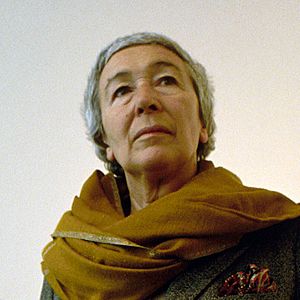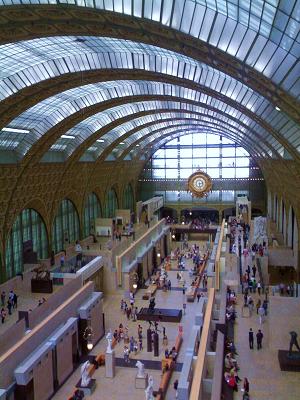Gae Aulenti facts for kids
Quick facts for kids
Gae Aulenti
|
|
|---|---|

Aulenti in 1986
|
|
| Born |
Gaetana Aulenti
December 4, 1927 Palazzolo dello Stella, Italy
|
| Died | October 31, 2012 (aged 84) Milan, Italy
|
| Education | Milan School of Architecture of the Polytechnic University |
| Known for | transforming historic public buildings into world renown museum spaces |
|
Notable work
|
|
Gae Aulenti (born December 4, 1927 – died October 31, 2012) was a very famous Italian architect. She designed many different things. Her work included industrial products, furniture, graphics, and even theater stages. She also designed lighting and interiors for buildings.
Gae Aulenti was especially known for her big museum projects. These include the Musée d'Orsay in Paris and the Contemporary Art Gallery at the Centre Pompidou. She also restored the Palazzo Grassi in Venice. Another major project was the Asian Art Museum of San Francisco.
Aulenti was one of the few women who became a top designer in Italy after World War II. Italian designers at this time wanted to create new and exciting architecture. They moved away from old, standard designs.
Gae Aulenti was very involved in the design world in Milan during the 1950s and 1960s. She was respected for her smart way of solving design problems. You can see how her ideas grew by reading the design magazine Casabella. She wrote for it often.
Her friends and fellow architects included Vittorio Gregotti, Giancarlo de Carlo, and Aldo Rossi.
Contents
Becoming an Architect
Gae Aulenti was born in Palazzolo dello Stella, Italy. She studied architecture at the Milan School of Architecture. This school is part of the Polytechnic University. She graduated in 1954. She was one of only two women in her class of 20 students.
When she was young, she loved playing the piano and reading. She once said she studied architecture because her parents wanted her to be "a nice society girl." She wanted to do something different. After graduating, she joined the staff of Casabella magazine. She and her friends were part of a movement called "Neo Liberty." They liked traditional building methods but also wanted to show their own unique style.
Designing a Career
Gae Aulenti started her own design business in Milan in 1954. She designed many interiors for big companies. Some of these were Fiat, Pirelli, and Olivetti. She also designed products for companies like Louis Vuitton and Artemide.
She also worked for the design magazine Casabella-Continuità from 1955 to 1965. She was an art director there, working on graphic design. Later, she joined the board of directors for Lotus International magazine. During this time, she was influenced by the ideas of Ernesto Nathan Rogers.
Aulenti also taught architecture. She was an assistant teacher at the Venice School of Architecture. She also taught at the Milan School of Architecture. From 1967, she gave talks at conferences in Europe and North America. She designed furniture for Zanotta. Two of her most famous pieces are the "April" folding chair and the "Sanmarco" table.
Transforming Famous Buildings
In 1981, Gae Aulenti was chosen for a huge project. She was asked to turn the old Gare d'Orsay train station in Paris into a museum. This station was a beautiful building from 1900. She transformed it into the Musée d'Orsay, a famous art museum. It displays French art from 1848 to 1915.
Her work on the Musée d’Orsay led to many other important jobs. She created a space for the National Museum of Modern Art in Paris. She also restored the Palazzo Grassi in Venice to be an art museum. She turned an old Italian embassy in Berlin into an Academy of Science. She also restored a 1929 exhibition hall in Barcelona. This became the Museu Nacional d'Art de Catalunya.
In San Francisco, she changed the city’s main library into a museum of Asian art. In 2011, she helped expand the Perugia Airport.
Aulenti also designed stages for plays. She worked with director Luca Ronconi. She designed six stores for fashion designer Adrienne Vittadini. She even designed the mannequins for the stores! She believed that a stage should be a real space, not just a decorated box.
She completed over 200 building projects in her career.
Gae Aulenti's Style
Gae Aulenti worked in Italy after World War II. Her designs used many different styles and ideas. She always wanted the people in a room to be the most important part. She believed that people make a room feel like a room.
She had a simple style. She once said, "My advice to whoever asks me how to make a home is to not have anything, just a few shelves for books, some pillows to sit on." She believed in lasting values over passing trends.
Selected Works
- Poltronova, Sgarsul Rocking Chair, 1962
- Poltronova, Locus Solus Collection, 1964
- Olivetti, Martinelli Luce Pipistrello Table Lamp, 1965
- Knoll, Jumbo Table, 1965
- Fontana Arte, Parola Lamps, 1980
- Fontana Arte, Tavalo con Route, 1980
- Fontana Arte, Tour, 1993
- Gaecolor Vase, 2005
- Olivetti Showroom in Paris, 1965
- Musee d'Orsay, 1980–1986
- National Museum of Modern Art at the Centre Georges Pompidou in Paris, 1982–1985
- Palazzo Grassi Renovation, 1985–1993
- National Art Museum of Catalonia (MNAC) Restoration, 1990
- Museum of Asian Art in San Francisco, 2003
- Palazzo Branciforte, Palermo
Awards and Legacy
Gae Aulenti passed away in Milan on October 31, 2012. This was just a few weeks before her 85th birthday. She had been sick for a while. Her last public appearance was on October 16, when she received a special career award.
Milan honored her by naming a public square after her, Piazza Gae Aulenti. This happened in December 2012, shortly after she died.
Some of Aulenti's drawings and designs are kept at the International Archive of Women in Architecture. This archive is at Virginia Tech.
Major Awards
- 1964: Grand International Prize at the Milan Triennial. Her winning piece was a room with mirrored walls. It had cut-out shapes of women, inspired by Picasso.
- 1980: Ubi Prize for Stage Design, Milan
- 1983: Architecture Medal, Academie d' Architecture, Paris
- 1984: Josef Hoffmann Prize, Vienna
- 1987: Chevalier de la Legion d' Honneur, France
- 1987: Commandeur, Order des Artes et Letters, France
- 1991: Praemium Imperiale
Gae Aulenti's Thoughts
Gae Aulenti shared many interesting thoughts about her work:
- "There are plenty of other talented female architects, but most of them seem to link up with men...I've always worked for myself, and it's been quite an education. Women in architecture must not think of themselves as a minority, because the minute you do, you become paralyzed. It is important to never create the problem."
- "It's not possible to define a style in my work. If you're designing an airport, then airplanes are important. It's no more complicated designing a museum. I prefer museums for my personal passion – the art."
- "When you're criticized for something, it's best to wait two or three years and see."
See also
 In Spanish: Gae Aulenti para niños
In Spanish: Gae Aulenti para niños


